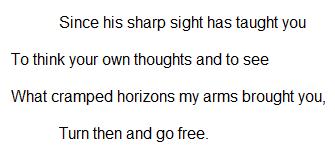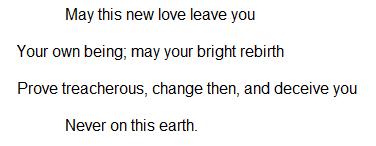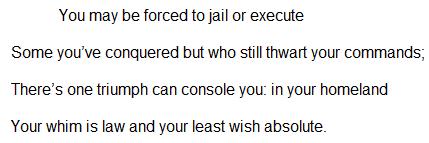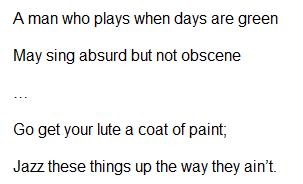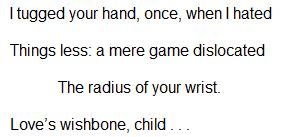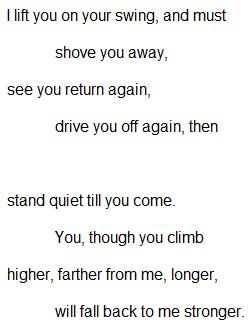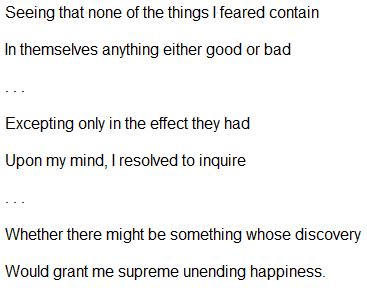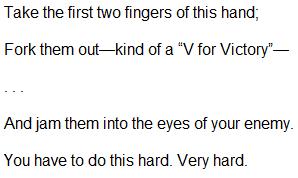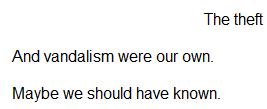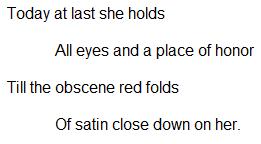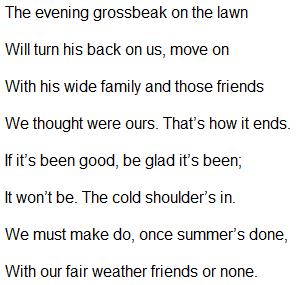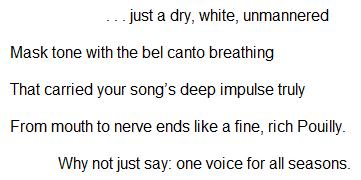Not for Specialists: New and Selected Poems by W.D. Snodgrass. BOA Editions, 2006.
As Reviewed By: Jan Schreiber
Have you boned up on your Snodgrass? There’s no time like the present. But it may take a while. There’s not really a typical Snodgrass poem that will immediately give a sense of the man and the work. Nor does any characteristic form stand out, although form is clearly important to the writer. Many of Snodgrass’s poems are characterized by what you might call exuberant experimentation, as forms and even meters are invented for the occasion. The emotional tones range from tenderly poignant to wickedly satirical. The subjects span art, nature, relationships, academic politics, and the Götterdämmerung of the Third Reich. And yet over time readers come to locate and respond to the distinct and appealing personality behind some extraordinary poems.
To a considerable degree, Snodgrass writes about himself. Poets can hardly avoid entering their poems, but often they employ a variety of disguises. Snodgrass, usually working without a mask, resembles Lowell, who put himself, his parents, and his wives and lovers into poems suffused with familial and conjugal strife, but he does not partake of Lowell’s mania. These poems convey the suffering that attends abandonment by a loved one, marital breakup, and the loss of a child through divorce. Without naming names, they offer convincing details of sexual trespass and sometimes duplicity. Readers can be forgiven for seeing them as autobiographical. Such frank displays of personal loss and anguish place Snodgrass among the “confessional” poets, although he remains so balanced and good-humored that some may feel he lacks the neuroses necessary to qualify.[private]
But these amiable qualities take no toll on his poems or his acumen. And they can be deceptive. For to retain balance in the face of the blows of fortune, the betrayals of erstwhile loves, one must have recourse to an irony that only the willfully naïve would mistake for simple good humor. Consider “A Valediction,” addressed to a woman who has left the poet for another man:
The bitter irony in every line borders on sarcasm, but it does not descend to raillery. The poem’s ostensible good wishes for a new life are artfully designed to look like curses until the sentence is completed—
—so that the curse, the intended statement, appears to be (but is not really) negated by the second half of the sentence. Thus the sad sarcasm prevails while the cancelled curse still echoes. The effect is to clarify the speaker’s pain while arousing in the reader something close to pity for a woman seen as moving blindly from a relationship in which she might have been happy to one in which she cannot be.
Although Snodgrass was a formalist long before the term became common currency, he has remained a relentless experimenter. More than most contemporary poets, he blends into his work what one might call found poetry—most often phrases from the letters, diaries, or spoken words of those he is writing about, but sometimes even the rhythms of utterances, including some that originated with the great horned owls in upstate New York.[1] These are incorporated in poems as the wren or the robin incorporates bits of string into its nest: the structure is the poet’s, but the exogenous phrases give life and veracity to the work.
The poem called “Van Gogh: ‘The Starry Night,’” for example, is daubed with quotations from the painter’s letters and diaries, and it builds from a restrained description of the sleeping village below to the mad ecstasies of the cartwheeling galaxies overhead—and then declines again, as if the painter’s (and the poet’s) intelligence had reined in the mania, till it settles in Van Gogh’s ambiguous last words, which Snodgrass in his notes translates as “This is the way to go” or “I’d like to die like this” or “I want to go home.”
Again, in the poems from The Fuehrer Bunker (1977, 1995), Snodgrass includes written and spoken phrases from Hitler, from Wagner’s operas, and from an early astrology manual. Poems in the voice of Albert Speer, Hitler’s architect, are shaped into typographic triangles that form architectural patterns. Those in the voice of Heinrich Himmler are printed on graph paper with all words in capitals, one letter to a square, fitting into rigid rectangles with dots between each word, and conveying a graphic image of a mind like the bed of Procrustes. If these poems succeed, and I believe they do, it is because they manage to combine a sense of the deranged minds behind the horror with the poet’s uninsistent sense of reality: an awareness that things will not fit in Himmler’s boxes or Speer’s triangles; an understanding that, in remarking “Casualties? But that is what / The young men are there for!” Hitler has lost touch (if he ever was in touch) with a fundamental reality. And even readers braced for Hitler’s monstrosity may be jolted by Snodgrass’s rendering of Magda Goebbels’ ersatz nursery songs as, with Soviet troops closing in, she feeds cyanide to children with a spoon.
Not that the poet’s horror is focused solely on the most notorious villains of prior generations. He is willing and able to draw disturbing parallels between the early days of the Nazi party and the recent history of the United States. In “The Discreet Advantages of a Reichstag Fire” he notes the usefulness of a manmade catastrophe in focusing a nation’s rage:
The poem proceeds to describe how civil liberties can be progressively curtailed in the name of “Protection of the People and the State.” And it concludes:
In our age that thinks of poetry as lyric, when it thinks of poetry at all, people are wary of fierce political statements in verse. I suppose there is some danger that we will be bombarded by dueling poetic firebrands as much as we have been by political interest groups on the airwaves. But like all such endeavors, political satire in verse can be done well or badly, and here it is done very well.
Snodgrass’s experiments also run to imitations and parodies. This retrospective includes selections from Kinder Capers, his book of poems for children, illustrated by his friend DeLoss McGraw. In addition to more traditional works (this section contains the only sonnets in the collection), there is a rather madcap imitation of Stevens’ “The Man with the Blue Guitar,” called “The Drunken Minstrel Rags His Bluegrass Lute.” The general ideas of the Stevens poem reappear here in off-key hipster diction:
A little of this goes a long way—and in general the children’s poems feel slightly forced and less than inspired—something that can rarely be said of Snodgrass’s grown-up writing.
But these missteps are atypical and stem, I believe, from a naturally exuberant, irrepressible quality in the writer, one that produces poems on all sorts of occasions, not just those calling for gravitas. Formally experimental or not, Snodgrass’s best poems are frank, deeply felt, and fearless. Virtually no subject is off limits. The poet writes of his marriages, their disintegrations, and their aftermaths. He writes of trysts in a featureless motel. He describes an evening spent with a couple and their children—an evening made exquisitely awkward by the reality that he and the woman of the couple are lovers. And, most famously, he catalogues the torment, over years, of living apart from his loved daughter as a result of separation and divorce: the “heart’s needle,” the “drop that brings a man to the ground.”
It was Heart’s Needle that made Snodgrass’s reputation when it was published in 1959. An anachronism at the time, in that it hewed to meter and dexterous (if somewhat permissive) rhyme, it was also quite contemporary in its willingness to expose personal details in a public forum:
The episode fits the poem, but it also convinces the reader that it really happened, was not simply invented to make a poem vivid. And because of that, it retains its power to bring the reader up short, however often he rereads the poem.
Yet what finally carries the day, and sets Snodgrass apart from such confessional poets as Plath and Lowell, is the tenderness and generosity of feeling evident in every poem. These qualities, sometimes frowned upon by those who believe a poet should be tough-minded to avoid sentimentality, are handled with great skill, as in his lines describing his daughter:
The passage has the character of an Elizabethan conceit, in the manner of Donne, except that it feels less contrived, more personal. But to achieve that feeling takes art.
That art involves considerable rational control, a control that, on the evidence of these poems, has not always come easy for the writer. Beneath a colloquial exterior lies a complex mind: the poet knows where he is going, but he is sometimes careless of leaving signposts. For example, the poem called “Fourth of July” from Remains cannot be descried on one reading. The second stanza tells us, “She stopped [died] a year ago today.” We don’t yet know who “she” is. We see her bedroom and her personal effects—“Her bedside asthma pipe, the glasses whose / Correction no one else will take.” But we must travel through ten more stanzas to arrive at the final one, where we finally learn, “It is an evil, stupid joke. / My wife is pregnant; my sister’s in her grave.” Then we can and must go back and reread the poem to fit its details into our new knowledge.
Another poem, “After Experience Taught Me,” interweaves two vastly different narratives, couplet by couplet, as if they were read antiphonally by two antagonists. One is a detailed set of instructions for maiming an adversary by gouging his eyes and ripping his face off. It is counterpointed by a series of ponderous meditative unrhymed couplets:
The slightly fatuous and otherworldly quality of these lines of course invites desecration, which the anti-poem supplies:
It is possible this strange amalgam represents self-criticism, either personal or literary, by Snodgrass, or that it embodies post-traumatic stress, but its shocking tone does not really move or enlighten this reader, nor does the forced yoking of the narratives offer illumination.
Such a poem could be called an example of the fearlessness I referred to earlier, but I mean something different by the term: the willingness to put one’s own humiliation and debasement on public display, boldly and without apology. In “The Last Time,” Snodgrass tells of a moment late in a previous marriage when his wife momentarily forgets her new infatuation and treats her husband with affection. “My breath failed me. I thought / It might all come back yet . . .” But then she turns back to the “tall young man in whom you’d shown, / In front of all our friends, such clear delight,” throws her arms around him, kisses him, “and then you / Said you were ready and we went along.”
Poems like this are by no means unprecedented in English literature, but they are not easy to write, and when written with such dramatic immediacy they evoke in readers complex emotions of sympathy and awkwardness, as if we were present and forced to witness, with deep discomfort, a crucial moment of betrayal.
Summing up: we are in the presence of a vigorous and subtle poet possessing, in his best poems, great technical control and a disarming ability to make engaging art of some harrowing experiences and reversals of fortune. When we step back and survey his work as a whole, what can we say?
A volume of new and selected poems published in advanced years (Snodgrass is 80) and arranged chronologically tempts a reader to see the poet’s wending life in the waystations he has erected—especially when he holds so little back. Viewed from that vantage, such a volume is essentially tragic: it opens with promise and ends facing demise. If the writer retains his powers of observation and expression into old age, then his life is his book, and even grace and wit (which Snodgrass has in great plenty) cannot long elate us.
We can see the arc of the life as we go from an early poem like “These Trees Stand,” with its slightly self-mocking but still confident refrain—“Snodgrass is walking through the universe”—to a poem of middle life, describing his return to “A Locked House” that, untended for two years, has kept the possessions he and his former wife once shared. Noting that the house has not been tampered with, he observes ruefully,
In due course we come to “Packing Up the Lute,” in which the poet says to the lute, which is a real instrument as well as a metaphor, “You / Were just too fine a vice to last.” And because the lute is metaphor too, and the “vice” is art and talent and life itself, and because the poem is written in an infectious meter, with an informal, intimate diction that one might use with a child or a lover, we experience a wrenching of the heart, something that happens now and then when an exceptional poem accosts us.
Among the earlier poems, even the most successful, a conventional poetic surface competes with the poet’s starker vision. At times coherence suffers. Riding the long, careening sentences, a reader must sometimes hang on for dear life. The “Hearts Needle” sequence begins with a single sentence snaking through six stanzas. For all its beauties of detail, the rational content of this sentence will escape most readers. It can be diagrammed, but until it is thus reduced to a schematic form, it is likely to remain a texture of fleeting though indelible moments (“Your mind a landscape of new snow,” “the lean foot / Of the weasel tracking”) rather than an intellectual proposition.
In the later poems these excesses are considerably chastened. By the time we come to “Viewing the Body” (from Remains (1970, 1985)), we find the path notably straighter. Three sentences are deployed over four stanzas; each is comprehensible without effort, though the second gets by without a main verb, and the third is decisive:
The poem closes with the finality of that coffin. Some twenty years later, Snodgrass composed the succinct sentences of “Autumn Variations,” aided now by rhymed tetrameter couplets:
Allusion is replaced by aphorism. Metaphor still has power, but the surface sheen is gone, revealing the stark, no-nonsense world that underlies it all.
And finally there is a relaxed style that can handle anything, imbuing even occasional poems with multiple meanings, as in these lines celebrating the eighty-fifth birthday of the singer Hugues Cuenod:
Why not, indeed? Snodgrass’s voice still serves. The poet who made a bigger splash in his youth (winning a Pulitzer with his first book) than he did in later years has grown in complexity of feeling and in power. The selection represented in this book should establish him as one of the major poets of the late twentieth century, and a model for younger writers pursuing a once-again fashionable formalism in the twenty-first.
1] An aside: thirty years ago when Snodgrass published “Owls” in X.J. Kennedy’s magazine Counter/Measures, the contributors’ notes indicated that he had actually notated the calls of the owls and would provide them on request. I requested and I received: Snodgrass really had recorded the prosody of the owls’ call—a prosody that became the basis for his poem.[/private]

